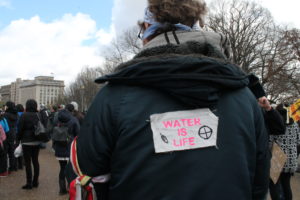
A Native protester wearing a “Water is Life” patch on the back of his jacket outside the White House. Photo by Julia Lewis.
This past week was a busy one for the Standing Rock Sioux Tribe.
From March 7 to 10, Native tribes from all across the nation gathered in Washington, D.C. in protest of the Dakota Access Pipeline (DAPL).
The first three days of the movement involved Native leaders and allies lobbying in national buildings around the nation’s capital and camping out in tipis in front of the Washington Monument.
“It’s seriously so cool that I get to be a part of this and represent,” Athena Sadongei, a Cherokee Native, said as she stood in front of the White House. “The weather sucks, but I honestly wouldn’t want to be anywhere else.”
The last day of the protest, popularly referred to on social media as “#NativeNationsRise” was spent marching on Washington from one end of the National Mall near the Judiciary Square Metro to Lafayette Park in front of the White House. The march itself lasted for roughly two hours with harsh weather conditions such as as sleet and hail. This did not dishearten the protesters, who during the march, stopped in front of the Trump International Hotel to stand against the President’s executive order proceeding the construction of the pipeline.
“It is clear that [Trump] does not respect our rights or self-determination,” environmental activist and Dakota tribe member Dallas Goldtooth shouted to the group of marchers. Goldtooth is also a member of The 1491s, a Native American comedy group, but he took on a serious demeanor during the protest. “As indigenous people, we take a stand to defend our people, to protect our rights and stand in defense of Mother Earth!”
The march itself was anything but quiet; Native cries and chants opposing the pipeline reverberated through the crowd. Several Native protesters brought drums and beat on them for the entire duration of the march. “Street by street, block by block, we stand with Standing Rock,” one protester chanted, which quickly echoed throughout the crowd. And while mainstream media did not heavily report on the event prior to its happening, thousands from all over the country made their presence known and their voices heard.
Once the march reached the White House, thousands rallied outside in Lafayette Park to voice their concerns against not only the pipeline construction but against the discrimination of Native Americans’ rights as well. Protesters spanned across the space of Lafayette Park and directly in front of the gate of the White House, shouting for attention from the federal government to their pleas.
Chantelle Cooke-Afriat, a member of the Akwesasne Mohawk nation and current resident of western North Carolina, said through Facebook correspondence that now, more than ever is the time for Native nations to unite and rise together to protect the environment.
“We are the protectors…This battle is so much more than just a fight against yet another pipeline and the devastating impacts these pipelines have on our lands.” Although Cooke-Afriat could not make it to the event, she spoke out in favor for it and voiced her solidarity and support for the movement. “We can’t be afraid to be heard. And to rise together.”
Although not part of the planned protest, the Native tribes gathered together Saturday morning in front of the Washington Monument for a closing ceremony, where they prayed for the earth and its healing, as well as their rights as a people. This is not the first time Native tribes have taken a stand against actions committed by the federal government. Indigenous people have marched on Washington to stand up for their rights and for their sacred lands.

A display in the American Indian Museum depicts Native marches on Washington in the past. Photo by Julia Lewis.
Although the fight against the Dakota Access Pipeline (the memorandum signed by President Trump Jan. 24, 2017) may be lost, this movement serves as an outcry to the construction of pipelines across sacred lands and is a step in the door for battling other constructs that pose a threat to the well-being of the environment. Water protectors from Alaska, Texas, New York and more now have the media attention they’ve been fighting for and there are movements across the nation to defend the environment.
“This movement has woken a sleeping giant so to speak, and brought unity to tribes and people from around the world,” Cooke-Afriat added. “This fight has just begun.”


